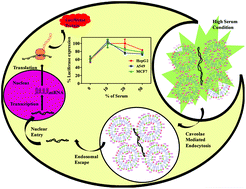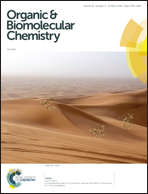Transfection efficiencies of α-tocopherylated cationic gemini lipids with hydroxyethyl bearing headgroups under high serum conditions†
Abstract
Herein, five new α-tocopheryl cationic gemini lipids with hydroxyethyl bearing headgroups (THnS, n = 4, 5, 6, 8, 12) have been synthesized for efficient plasmid DNA (pDNA) delivery into cancer cells. Among these gemini lipid formulations, the lipid with an octamethylene [-(CH2)8] spacer (TH8S) showed the highest transfection efficiency (TE) that was comparable to that of the commercial standard lipofectamine 2000 (L2K) in terms of luciferase expression in HepG2 (liver hepatocellular carcinoma) cells. The addition of the helper lipid DOPE (1,2-dioleoyl phosphatidyl ethanolamine) with cationic lipids in mixed liposomes further enhanced the TE and the optimized molar ratio was 2 : 1 (DOPE : cationic lipid). The optimized co-liposomal formulation of TH8S (DOPE : TH8S = 2 : 1) showed a higher TE in HepG2, A549 (human lung carcinoma) and MCF7 (human breast adenocarcinoma) cells than other optimized co-liposomal formulations and was also significantly more potent than L2K. The comparison of the TE of DOPE–TH8S (2 : 1) with the gemini lipid T8T (the headgroup devoid of the hydroxyl group) further demonstrated the importance of the hydroxyethyl functionality at the level of the headgroup. Relatively good binding efficiency and easy release of pDNA (pGL3) were also observed with DOPE–TH8S (2 : 1) in the ethidium bromide (EB)-exclusion and re-intercalation assay, which may be the plausible reason for high TE. The lipoplexes were also characterized by atomic force microscopy (AFM), dynamic light scattering (DLS), zeta potential and small angle X-ray diffraction experiments. Greater cellular internalization of fluorescein tagged pDNA was also observed with DOPE–TH8S (2 : 1) lipoplexes compared to that with L2K. Retention of the TE of DOPE–TH8S (2 : 1) lipoplexes under high serum conditions was conferred by the presence of the tocopherol backbone and also the hydroxyethyl functionalities. The cellular internalization pathway of the lipoplexes was characterized by performing transfection experiment in the presence of inhibitors of different endocytic pathways and it was found to be caveolae mediated. An MTT based cell viability assay indicated that the lipoplex mediated gene delivery vectors exhibited low toxicity in all the three cancer cell lines studied.



 Please wait while we load your content...
Please wait while we load your content...